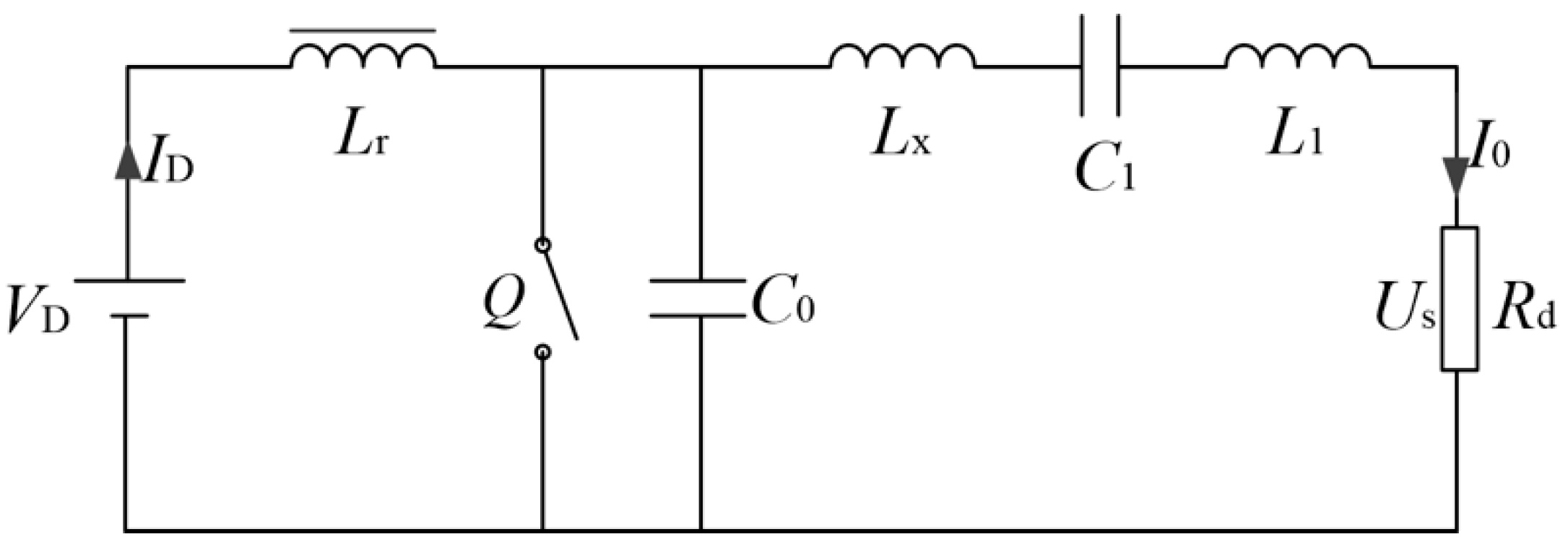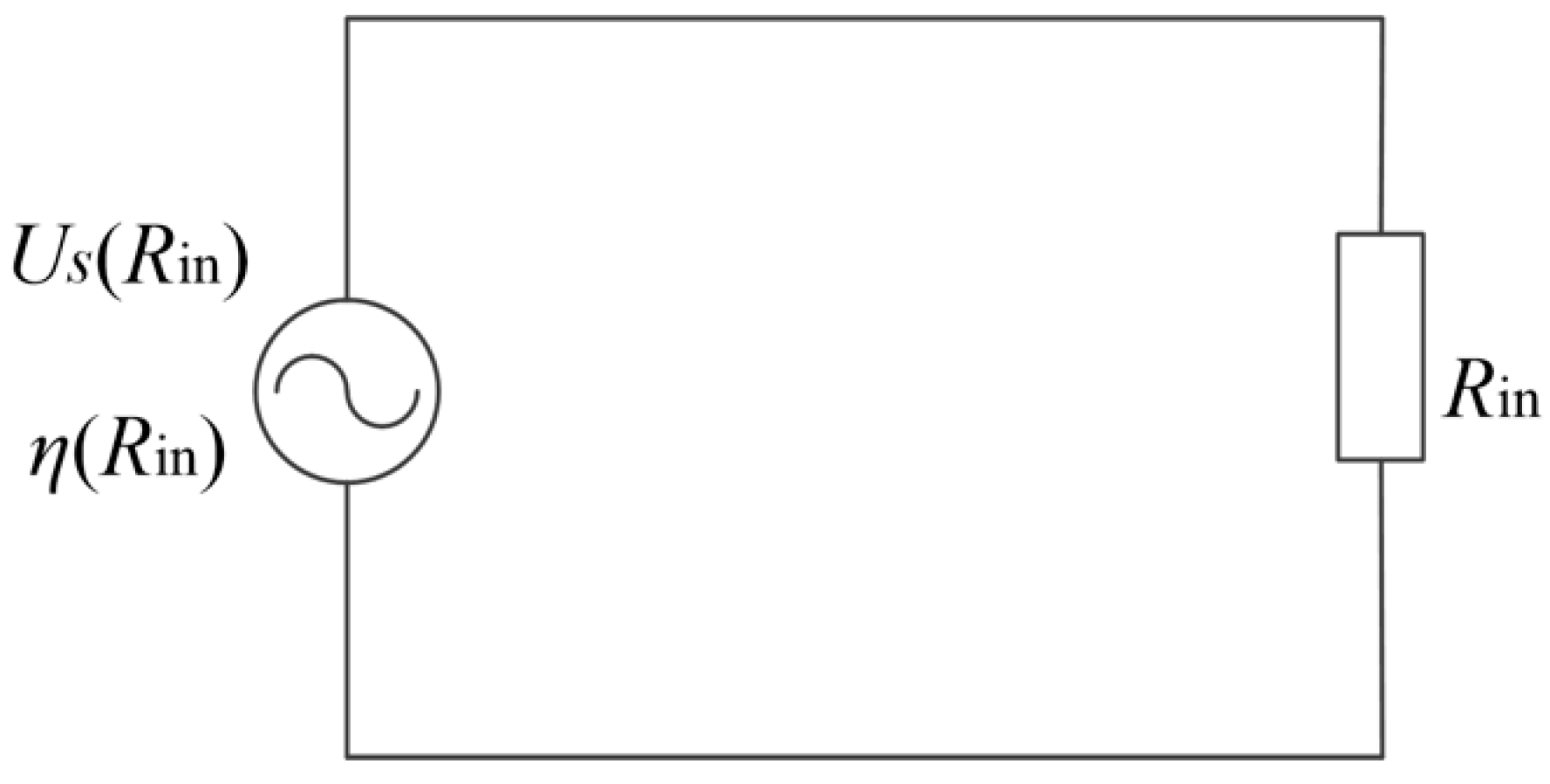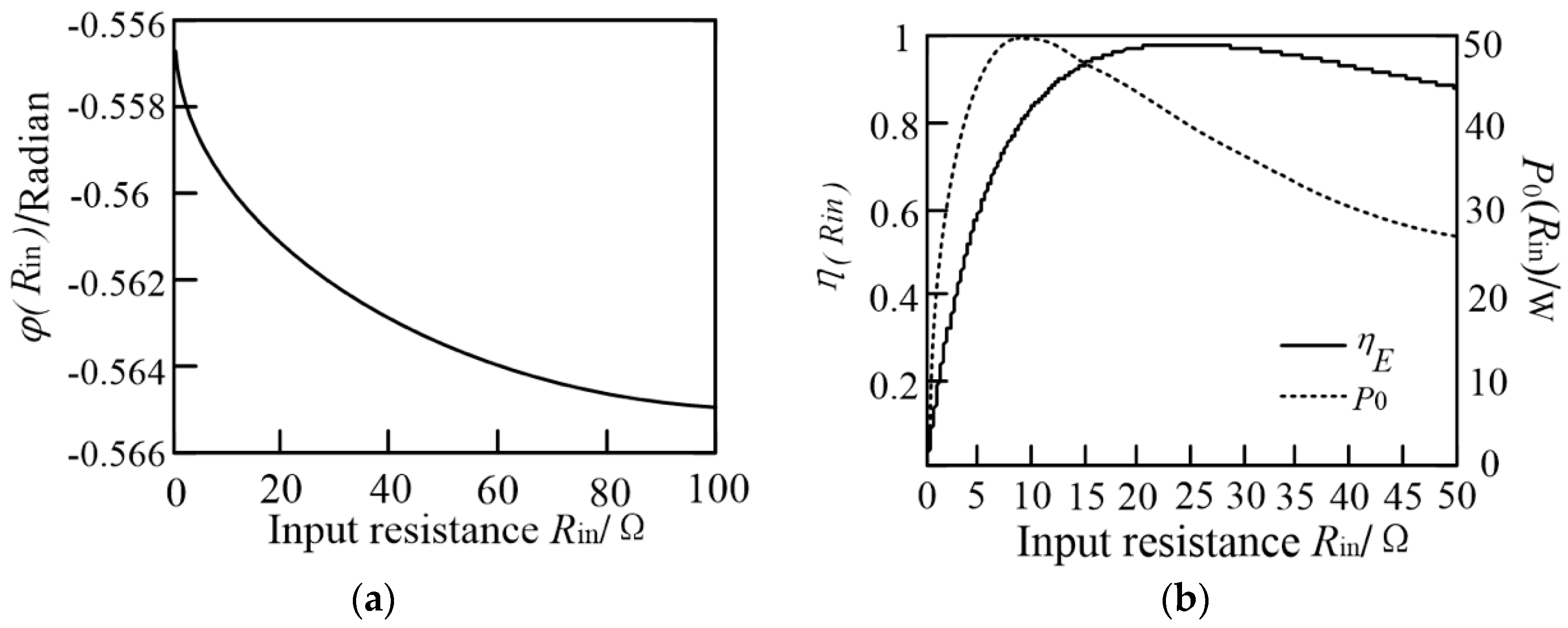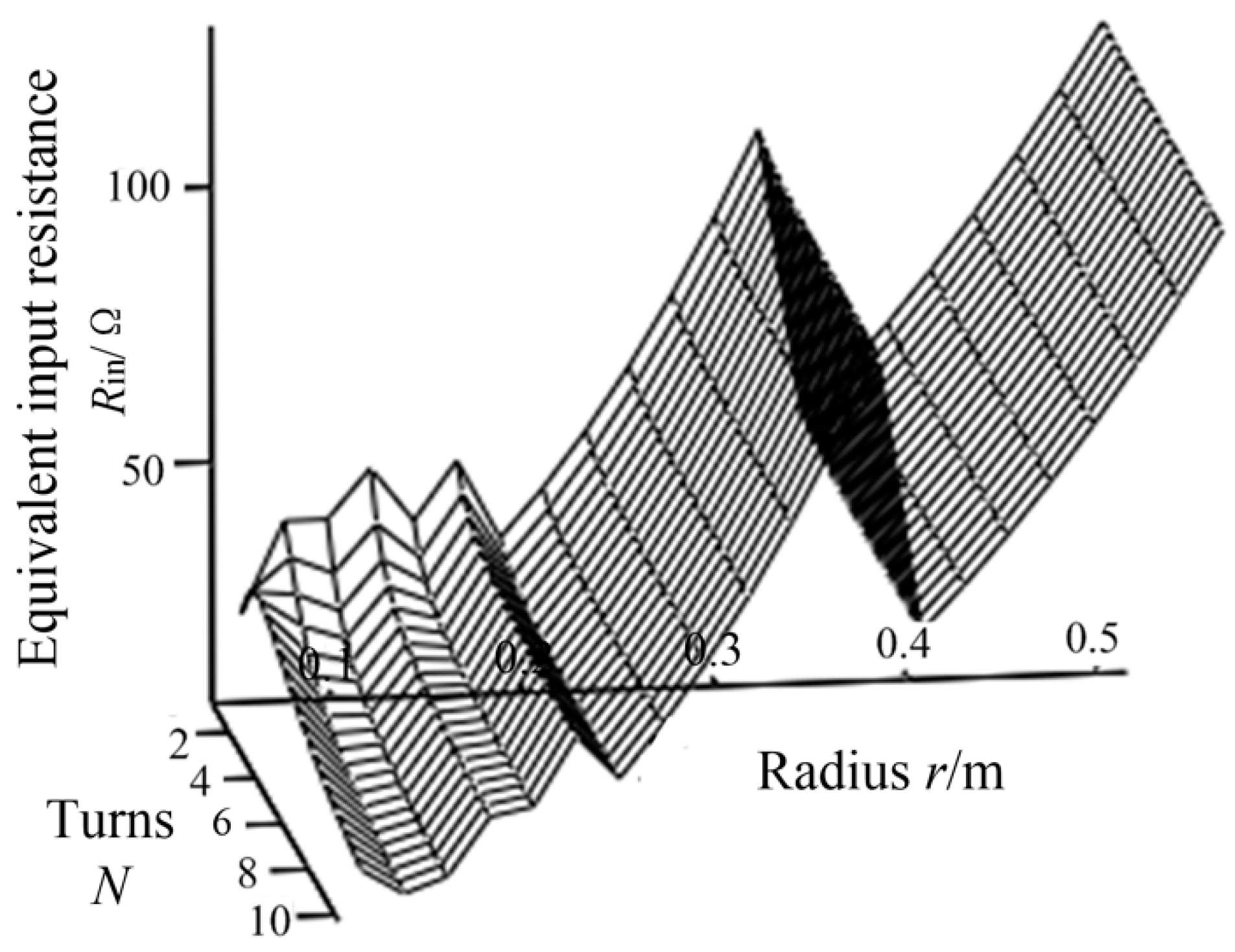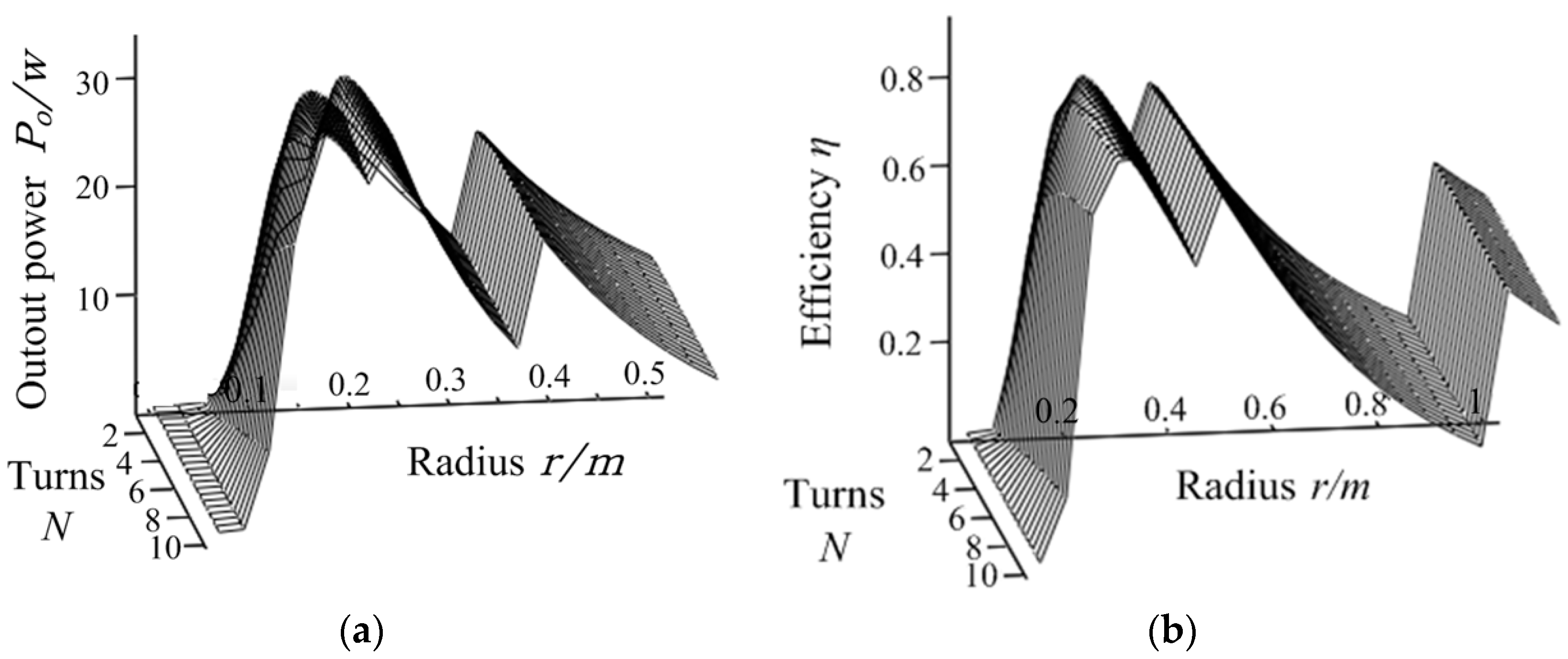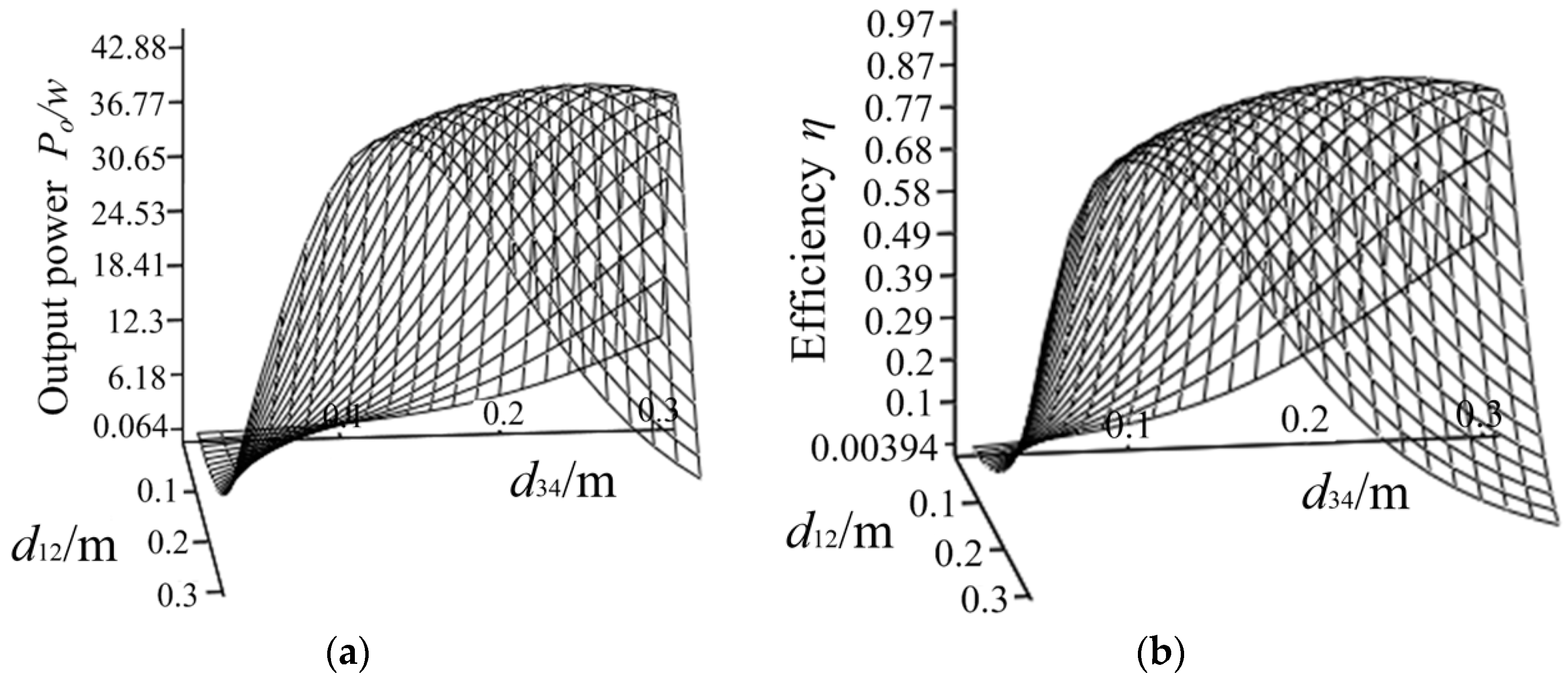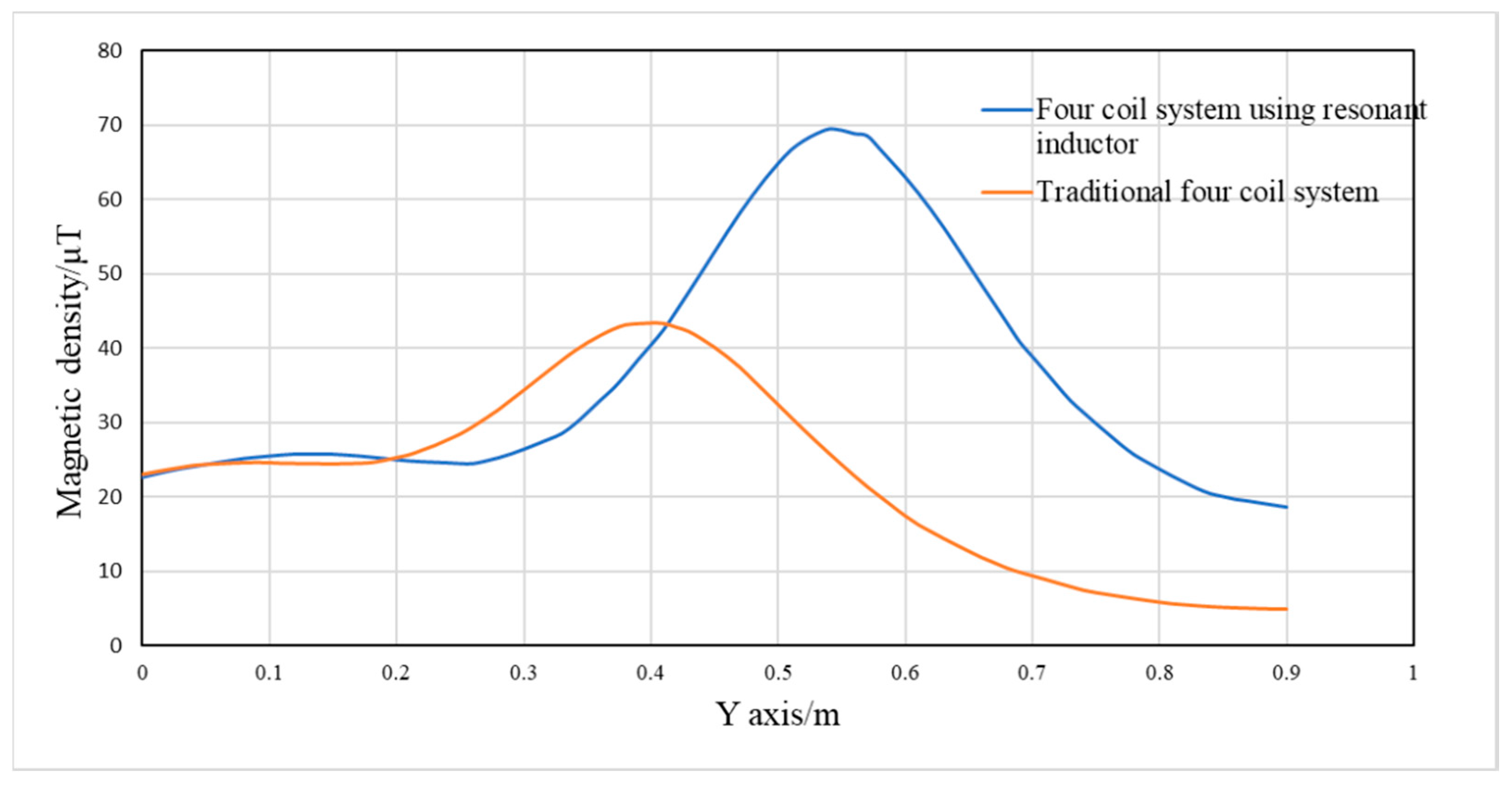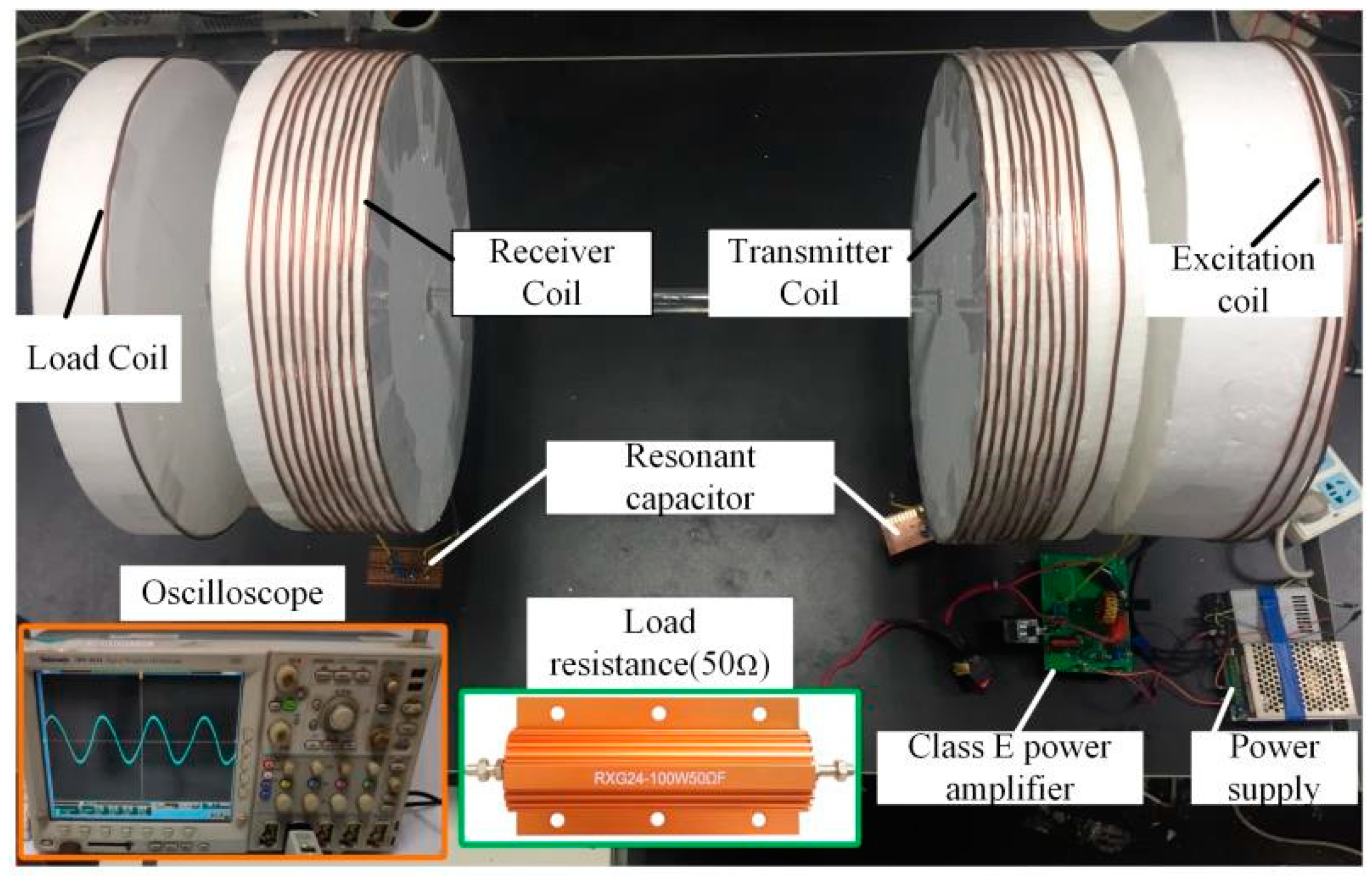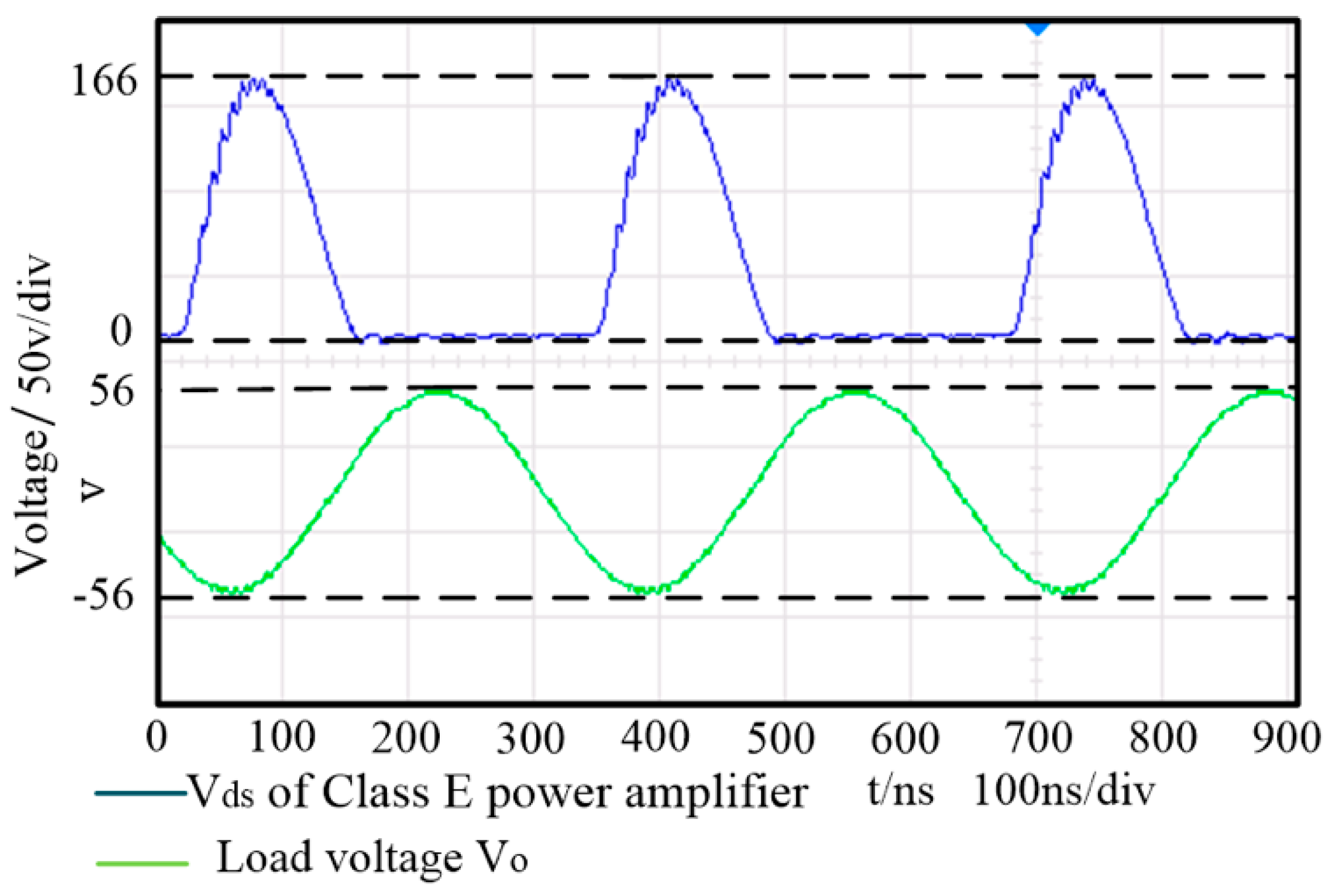1. Introduction
Since
2007, wireless power transfer (WPT) technologies have been widely concerned and studied because of their flexibility and security in power supply [
1,
2,
3,
4]. It is troublesome to use a wired charging mode to charge electronics and sensors spread across a geographical area. However, existing wireless charging equipment has a short transmission distance. Four-coil WPT systems with class E power amplifiers as high frequency power supply are widely researched because of the advantages of long transfer distance, simple structure and high efficiency. In reference [
5], a novel four-resonator coil structure is presented to improve system efficiency. The source and load coils are designed to acquire high-loaded Q (quality factor) and maximum cross coupling coefficients, which increase system efficiency effectively. In reference [
6], a high-efficiency WPT system with an asymmetric four-coil resonator is proposed. Two intermediate coils boost the apparent coupling coefficient at around the operating frequency. Reference [
7] proposes methods to improve the transmission range by optimizing the magnetic mechanism and the distribution of auxiliary coils. Reference [
8] demonstrates, explains and analyzes frequency-splitting phenomenon by using the circuit theory. A solution is proposed that helps improve the efficiency when frequency-splitting occurs. The theoretical calculations and experimental results provide a sound basis. In reference [
9], a four-coil WPT system is designed by laying a lumped coil on the ground to realize the wireless power supply over a distance of 0.4 m. The transfer distance is not enough for modern wireless systems especially for electronics and sensors, since they may be widely distributed in high-voltage facilities, for example, the Ubiquitous Electric Internet of Things (UEIOT). The power transfer distance needs to be increased to ensure the safety of charging process. In reference [
10], the equivalent circuit model of four coil wireless energy transmission system is established and the efficiency analysis is carried out. The expression of coupling coefficient between coils is derived when the maximum system efficiency is achieved. It can be applied to optimize the parameters of four-coil system. Reference [
11] analyzes the relationship between transmission efficiency, transmission distance and mutual inductance when using four-coil system to charge laptop, and the transmission efficiency is up to 52%. Further improvement on the transfer efficiency is necessary in practical applications.
For the traditional four-coil WPT system, the impedance matching network to make the equivalent resistance of coil system consistent with the ideal load of class E power supply is essential to keep high performance of output power. However, the impedance matching network will inevitably increase the system complexity and results in extra power loss. The existing studies mainly concentrate on improving efficiency and transmission distance of four-coil WPT system by optimizing the coupling coils, however, the solutions of integrated design of power supply topology and four coil coupling mechanism are not intensively researched.
In this study, we propose a high-performance medium and long-distance wireless charging system with four-coil WPT system and class E power amplifier sharing a single resonant inductor. The proposed system does not use additional impedance matching network which reduces the complexity of the traditional four-coil system and has the characteristics of high efficiency, flexibility and long transmission distance. First, the theoretical model of four-coil system using resonant inductor in class E power amplifier is established and the principle of the model is analyzed in detail. The coil system is modeled based on mutual inductance theory and analyzed as the equivalent input resistance of class E power amplifier. The equivalent input resistance can be adjusted by the design of coil radius, turns and distances between coils. Second, the output voltage of class E power amplifier can be described as a function of input resistance when other parameters are constant. The design of power supply and four-coil system are combined for consideration. Under the given design requirements, the output power and efficiency of the system can be expressed as a function of turns and diameter of coils only. Finally, an experimental prototype is designed based on this method and verified by simulation and experimental results. The performance of the traditional four-coil WPT system and the proposed WPT system using resonant inductor in class E power amplifier are compared. The experimental results show that the output power of the system is increased by 18.7%, the efficiency is increased by 11% and the transmission distance is up to 0.7 m, which is suitable for wireless power supply of electronics and sensors.
2. Principle and Theoretical Model
The resonant frequency of the LC resonant circuit in class E power amplifier is the same as that of four-coil WPT system. As a result, the resonant inductor L in class E power amplifier can be used as excitation coil in four-coil WPT system. In this theoretical model, it is necessary to design parameters of excitation coil in four-coil system to make its inductance consistent with that of resonant inductance in class E power amplifier. In addition, it is necessary to design parameters of four coils to make the equivalent input resistance of four-coil system match the optimal load resistance of class E power amplifier. In this way, class E power amplifier can leave out the impedance matching network, so as to simplify the system structure and reduce the power loss.
Figure 1 shows the circuit schematic of the proposed WPT system using resonant inductor in class E power amplifier. In this system, SS (SS is a basic circuit topology in WPT system, which is characterized by the fact that transmitter coil and its tuning capacitor are in series resonance, receiver coil and its tuning capacitor are in series resonance) compensation structure is adopted for simplification. The circuit includes DC input power supply
VD, gate drive signal, switch
Q, capacitor in parallel
C0, excitation coil and resonant inductor
L1, transmitter coil
L2, receiver coil
L3, load coil
L4, load
RL of four-coil system, resonant capacitor
C1,
C2,
C3,
C4 and parasitic resistance
R1,
R2,
R3,
R4. Residual inductor of traditional class E power amplifier which provides a certain inductive reactance for the circuit to improve the power factor is not concerned in this study since we focus on streamlined WPT structure and excellent transfer efficiency.
First of all, the ideal working conditions of class E power amplifier is analyzed.
Figure 2 is the equivalent circuit of class E power amplifier.
Lr is the high frequency choke,
LX is the residual inductor,
Rd is the load resistance,
I0 and
Us is the load current and output voltage. The relationship between the load resistance and the output voltage of class E power amplifier is given in reference [
12]. When the duty cycle of the driving signal is 0.5, we can get:
where
X =
ω L1 − 1/(
ω C1),
ω is the angular frequency,
φ is the phase of load current,
ID is the DC input current,
P0 is the output power. According to Formula (1), in class E power amplifier, when the parameters except the load resistance are determined, the load resistance has little effect on the phase (This can also be verified in Figure 5a in
Section 3.2). Hence, the phase can be approximately considered as constant. According to Formula (2)–(4), when the phase is considered constant, output voltage
Us can be regarded as related only to the load resistance.
The transfer efficiency [
13] of class E power amplifier is also a key index of system performance that can be expressed by:
where,
rDS is the on resistance of switch,
Pton is the turn-on loss,
rL is the parasitic resistance of resonant inductor,
tf is the fall time of switching signal,
f is the power frequency which equals 2
π/
ω. It can be seen from above analysis that the main power loss comes from switching loss. Therefore, to obtain an efficient class E power amplifier, a switch with low on resistance and short on-off time is essential.
According to Formula (1)–(7), the power and efficiency of class E power amplifier are obtained. For a class E power amplifier with a duty cycle of 0.5, the ideal optimal working conditions [
14] can be obtained by:
where,
R is the ideal load resistance of class E amplifier when duty cycle is 0.5,
QL is the quality factor of the excitation coil.
According to the circuit schematic shown in
Figure 1, the Kirchhoff laws (KVL) equation of four-coil system using resonant inductor in class E power amplifier can be listed:
where,
M12 is the mutual inductance between excitation and transmitter coil,
M23 is the mutual inductance between transmitter and receiver coil,
M34 is the mutual inductance between receiver and load coil.
Z2 = R2 + jωL2 + 1
/jωC2,
Z3 = R3 + jωL3 + 1
/jωC3,
Z4 = R4 + jωL4 + 1
/jωC4. The mutual inductance between coils far apart is ignored.
For the purpose of achieving high transmission efficiency, all coils are compensated to resonance to reduce the reactive loss except the excitation one. Therefore, Im(Z2) = Im(Z3) = Im(Z4) = 0. Since excitation coil is the resonant inductor in class E power amplifier, its value can be obtained in Formula (9) and (10) with capacitor C1.
According to Formula (12), the output power, the transfer efficiency and the equivalent input resistance of the four coils can be obtained:
where,
POC is the output power of the proposed WPT system using resonant inductor in class E power amplifier.
ηc is the efficiency of the system.
Rin is the equivalent input resistance of the four coils.
According to Formula (13), the proposed WPT system using resonant inductor in class E power amplifier can be equivalent to a series structure of power supply voltage and input resistance. The schematic diagram of equivalent circuit is shown in
Figure 3. Where,
Us (
Rin) is the output voltage of class E power amplifier when the equivalent input resistance is equal to
Rin.
η (
Rin) is the efficiency of class E power amplifier when the equivalent input resistance is equal to
Rin. It can be noted that the target of obtaining high output power and efficiency is transformed to figure out the optimized values of mutual inductance between coils and equivalent input resistance.
The coils involved in this study are coaxial spiral coils, which are wound with copper wire and with turn spacing to reduce the influence of proximity effect. The calculation formula of parasitic resistance of spiral coil [
15] is as follows:
where,
μ0 is permeability of vacuum,
σ is the conductivity,
a is the copper wire radius,
N is the turns of coil,
r is coil radius.
Mutual inductance between coils can be obtained by Neumann Formula [
16]:
where,
N1 and
N2 are the turns of two coils, respectively,
d is the axial distance between coils,
r1,
r2 are the radius of the coils,
θ and
φ are the integral factors of the coils which represent angles between the normal of coil-infinitesimal-element and x-axis.
In practical design of the proposed WPT system using resonant inductor in class E power amplifier, the output power
P0, the transmission distance
d23 and the angular frequency
ω will be given. According to the required power and frequency, the class E power amplifier can be designed. Combining reference [
17] and Formula (16), the parameters of resonant inductor
L1 can be obtained.
where,
μrc is the relative permeability of the magnetic core,
lc is the core length,
lc = Na + (N − 1)s, s is the turn spacing.
To analyze the transmission efficiency of this system, we select
N, r as basic design variable, the function
R (N, r) of the equivalent input resistance can be obtained. Then, the output power
P0 and the system efficiency
η can be expressed as functions
P0 (N, r),
η (N, r). As a result, the relationship between the coil-parameters
N,
r and the system transmission efficiency can be analyzed. The power and efficiency are as follows:
5. Experiment
The experimental devices are shown in
Figure 12. The measuring equipment is Tektronix DPO 4034 digital oscilloscope. The voltage probe is dp6150 high voltage differential probe and the current probe is Tektronix tcp0150. The working frequency of class E power amplifier is 3 MHz, the resonant inductor
L1 = 8.6 μH, the resonant capacitor
C1 = 370 pF, the capacitor in parallel
C0 = 400 pF, the coil radius
r = 0.2 m, the turns of excitation coil
N1 = 3, the turns of transmitter and receiver coil
N = 10, and the load coil is single-turn. The distance between the excitation and the transmitter coil is
d12 = 0.15 m, the distance between the transmitter and the receiver coil is
d23 = 0.4 m, and the distance between the receiver and the load coil is
d34 = 0.16 m.
Figure 13 shows the load voltage
V0 and the output voltage of the class E power amplifier
Vds of the proposed WPT system under optimal operating condition. The input current equals 1.1 A.
Figure 14 shows
V0 and
Vds of the traditional WPT system under optimal operating condition. The comparison between the experimental results and the theoretical values is shown in
Table 8.
It can be seen from
Table 8 that the efficiency and output power of the two types of WPT systems are basically consistent with the design index, which verifies the correctness of the proposed design method. According to the
Vds of the class E power amplifier in
Figure 13 and
Figure 14, it can be seen that the power module works under Zero Voltage Switch (ZVS) and Zero Current Switch (ZCS) conditions with little amplitude of vibration. There are measurement and debugging errors in coil tuning and equivalent input resistance matching, which results in lower efficiency and output power of experimental results than the theoretical results. In the experiment, the input power of the two WPT systems is 44 W. The output power of the proposed WPT system is 31.8 W. Compared with the traditional one, the output power of the proposed WPT system is increased by 18.7% and the transfer efficiency is increased by 11%.

